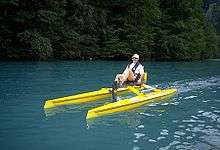Human-powered watercraft


Human-powered watercrafts are watercrafts propelled by human power.
The three main methods of collecting human power are directly from the hands or feet, through the hands with oars, paddles, or poles, or through the feet with pedals and a crank or treadle.[1]
While most human-powered watercraft use buoyancy to maintain their position relative to the surface of the water, a few, such as human-powered hydrofoils and human-powered submarines, use hydrofoils, either alone or in addition to buoyancy.
Oared craft
Oars are held at one end, have a blade on the other end, and pivot in between in oarlocks.
Oared craft include:

Using oars in pairs, with one hand on each oar, is two-oar sculling. The oars may also be called sculls.[2]
Two-oared sculled craft include:
- Adirondack guideboat
- Banks dory, Gloucester dory, and McKenzie River dory
- Dinghy
- Scull, Single scull, Double scull, Quad scull, and Octuple scull
- Skiff
- Row boat
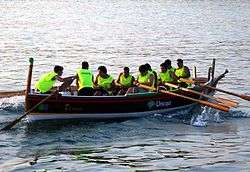
Using oars individually, with both hands on a single oar, is sweep or sweep-oar rowing.[2] In this case the rowers are usually paired so that there is an oar on each side of the boat.
Sweep-oared craft include:
- Coxless pair, Coxed pair, Coxless four, Coxed four, and Eight
- Galley, Dromon, Trainera, and Trireme
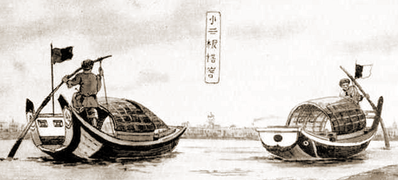
Moving a single stern-mounted oar from side to side, while changing the angle of the blade so as to generate forward thrust on both strokes, is single-oar sculling.[3]
Single-oar sculled craft include:
Paddled craft
A paddle, with a blade on one or both ends, is held with both hands.
Paddled craft include:
- Canoe, Outrigger canoe, Umiak, Waka, Pirogue, Shikara, Dragon boat, and Dugout
- Kayak, Sea kayak, Flyak, and Baidarka
- Coracle
- Surfboard
Pedaled craft
Pedals are attached to a crank and propelled in circles, or to a treadle and reciprocated, with the feet. The collected power is then transferred to the water with a paddle wheel, flippers,[4][5][6] or to the air or water with a propeller.
Pedaled craft include:
- Amphibious cycle
- Hydrocycle
- Pedal-powered kayak[4][5][6]
- Pedal-powered submarine[7][8]
- Pedal-powered hydrofoil
- Pedalo
Poled craft
A pole is held with both hands and used to push against the bottom.
Poled craft include:
Other types
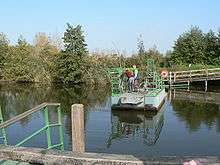
Other types of human-powered watercraft include:
Gallery
-

Hand paddling surfboards
-

Polling a raft
-

Sculling a gondola
-

Paddling an umiak
-
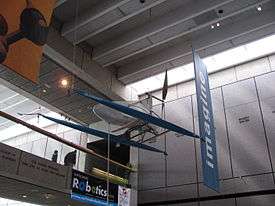
Decavitator, the world's fastest human-powered watercraft, is a pedal-powered hydrofoil
-
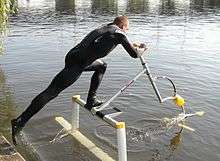
Starting an AquaSkipper hydrofoil
See also
References
- ↑ David Gordon Wilson (2007). "Pedal Power: Chapter 1 - Human Muscle Power in History". Green-Trust.Org. Retrieved 2011-07-27.
- 1 2 "Sweep vs. Sculling". Virginia Boat Club. Retrieved 2011-07-27.
- ↑ Joseph Needham, Colin A. Ronan (1978). The Shorter Science and Civilisation in China. Cambridge University Press. ISBN 9780521315609. Retrieved 2011-07-27.
- 1 2 Mike Hanlon (June 4, 2004). "Hobie Pedal Kayak". GizMag. Retrieved 2015-10-22.
The sturdily constructed pedal/flipper mechanism operates like a penguin's fins - swinging laterally underneath the hull as you pedal.
- 1 2 T. Edward Nickens (Mar 8, 2010). "How to Catch Big Game Fish—From a Kayak". Popular Mechanics. Retrieved 2015-10-22.
It's outfitted with the MirageDrive propulsion system, a pedal-powered pair of flexible fins that function as oscillating foils—much like penguin and sea-turtle flippers.
- 1 2 "Pedal-powered paddles a relaxing way to explore". The Daily Telegraph. Oct 30, 2008. Retrieved 2015-10-22.
Instead of a conventional paddle, these kayaks can be powered by a foot-pedal system which drives two under-keel fins. Inspired by penguin flippers, the fins swing side to side.
- ↑ Charlie Sorrel (Oct 19, 2010). "Pedal Powered Submarine Dives to 20-Feet". Wired. Retrieved 2015-10-22.
The Scubster is an underwater bike, a pedal powered submarine with twin propellors that push it through the water at a speedy 5mph.
- ↑ Timon Singh (Aug 25, 2010). "French Engineers Design a Pedal-Powered Submarine". Inhabitat. Retrieved 2015-10-22.
First there was the bicycle, then the pedalo boat, then the pedal-powered aircraft — and now, thanks to a team of French engineers, the world has the pedal-powered submarine.


